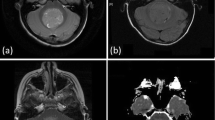Abstract
Purpose
To investigate the contribution of preoperative apparent diffusion coefficient (ADC) values in the differential diagnosis of pediatric posterior fossa tumors.
Methods
Forty-two pediatric patients (mean age 7.76 ± 4.58 years) with intra-axial tumors in the infra-tentorial region underwent magnetic resonance imaging. ADC measurement was performed using regions of interest, obtained from the solid component of the mass lesions. ADC ratios were calculated by dividing the ADC values from the mass lesions by the ADC values from normal cerebellar parenchyma. Lesions were categorized as juvenile pilocytic astrocytoma (JPA), ependymoma and medulloblastoma based on histopathological diagnosis. ADC values of the lesions and histopathological diagnoses were statistically correlated.
Results
Histopathological diagnosis showed that 14 lesions were JPA, 10 were ependymoma; 18 were medulloblastoma. Both ADC values and ADC ratios were significantly correlated with tumor types (p <0.05). Astrocytoma was distinguished from ependymoma with sensitivity 85.7% and specificity 90% using an ADC ratio ≥1.7 and medulloblastoma was distinguished from ependymoma with sensitivity 100% and specificity 88.89% using an ADC ratio ≤1.18.
Conclusion
Preoperative ADC values could differentiate the main histological subtypes of pediatric posterior fossa tumors with high sensitivity and specificity.



Similar content being viewed by others
References
Walker PA, Perilongo G, Punt JAG, Taylor RE. Brain and spinal tumors of childhood. London: Arnold; 2004.
Legler JM, Gloeckler Ries LA, Smith MA, Warren JL, Heineman EF, Kaplan RS, et al. Brain and other central nervous system cancers: recent trends in incidence and mortality. J Natl Cancer Inst. 1999;91:1382–90.
Gold E. Epidemiology of brain tumors. Rev Cancer Epidemiol. 1982;1:245.
Panigrahy A, Bluml S. Neuroimaging of pediatric brain tumors: from basic to advanced magnetic resonance imaging (MRI). J Child Neurol. 2009;24(11):1343–65.
Gimi B, Cederberg K, Derinkuyu B, Gargan L, Koral KM, Bowers DC, Koral K. Utility of apparent diffusion coefficient ratios in distinguishing common pediatric cerebellar tumors. Acad Radiol. 2012;19(7):794–800.
Jaremko JL, Jans LB, Coleman LT, Ditchfield MR. Value and limitations of diffusion-weighted imaging in grading and diagnosis of pediatric posterior fossa tumors. AJNR Am J Neuroradiol. 2010;31(9):1613–6.
Rumboldt Z, Camacho DL, Lake D, Welsh CT, Castillo M. Apparent diffusion coefficients for differentiation of cerebellar tumors in children. AJNR Am J Neuroradiol. 2006;27(6):1362–9.
Koral K, Alford R, Choudhury N, Mossa-Basha M, Gargan L. Applicability of apparent diffusion coefficient ratios in preoperative diagnosis of common pediatric cerebellar tumors across two institutions. Neuroradiology. 2014;56(9):781–8.
Maier SE, Sun Y, Mulkern RV. Diffusion imaging of brain tumors. NMR Biomed. 2010;23(7):849–64.
Kono K, Inoue Y, Nakayama K, Shakudo M, Morino M, Ohata K, Yamada R. The role of diffusion-weighted imaging in patients with brain tumors. AJNR Am J Neuroradiol. 2001;22(6):1081–8.
Graham DI, Lantos PL. Greenfield’s neuropathology. 7th ed. London: Hodder Arnold; 2002.
Giangaspero F, Eberhart CG, Haapasalo H, Pietsch T, Wiestler OD, Ellison DW. Medulloblastoma. In: Louis DN, Ohgaki H, Wiestler OD, Cavenee WK, editors. WHO classification of tumours of the central nervous system. 4th ed. Lyon: IACR; 2007. p. 132–40.
Scheithauer BW, Hawkins C, Tihan T, VandenBerg SR, Burger PC. Pilocytic astrocytoma. In: Louis DN, Ohgaki H, Wiestler OD, Cavenee WK, editors. WHO classification of tumours of the central nervous system. Lyon: IACR; 2007. p. 14–21.
Koral K, Mathis D, Gimi B, Gargan L, Weprin B, Bowers DC, Margraf L. Common pediatric cerebellar tumors: correlation between cell densities and apparent diffusion coefficient metrics. Radiology. 2013;268(2):532–7.
McLendon RE, Wiestler OD, Kros JM, Korshunov A, Ng H-K. Ependymoma. In: Louis DN, Ohgaki H, Wiestler OD, Cavenee WK, editors. WHO classification of tumours of the central nervous system. 4th ed. Lyon: IACR; 2007. p. 74–8.
Yamasaki F, Kurisu K, Satoh K, et al. Apparent diffusion coefficient of human brain tumors at MR imaging. Radiology. 2005;235:985–91.
Gauvain KM, McKinstry RC, Mukherjee P, et al. Evaluating pediatric brain tumor cellularity with diffusion-tensor imaging. AJR Am J Roentgenol. 2001;177:449–54.
Author information
Authors and Affiliations
Corresponding author
Ethics declarations
Conflict of interest
The authors declare that they have no conflict of interest.
Ethical statement
This work was approved by the local institutional review board.
About this article
Cite this article
Zitouni, S., Koc, G., Doganay, S. et al. Apparent diffusion coefficient in differentiation of pediatric posterior fossa tumors. Jpn J Radiol 35, 448–453 (2017). https://doi.org/10.1007/s11604-017-0652-9
Received:
Accepted:
Published:
Issue Date:
DOI: https://doi.org/10.1007/s11604-017-0652-9




